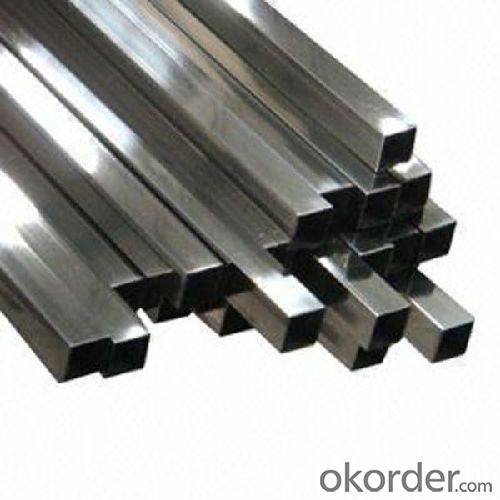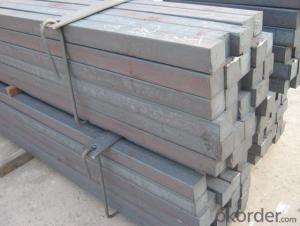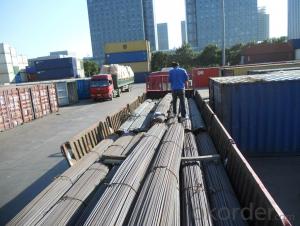Steel Square Bar 5mm-100mm Q195 or Q235 top quality
- Loading Port:
- China main port
- Payment Terms:
- TT OR LC
- Min Order Qty:
- 50 m.t.
- Supply Capability:
- 10000 m.t./month
OKorder Service Pledge
OKorder Financial Service
You Might Also Like
Steel Square Bar High Quality 5mm-100mm Q195 or Q235
Product Description:
OKorder is offering High Quality Square Bar 5mm-100mm Q195 or Q235 at great prices with worldwide shipping. Our supplier is a world-class manufacturer of steel, with our products utilized the world over. OKorder annually supplies products to European, North American and Asian markets. We provide quotations within 24 hours of receiving an inquiry and guarantee competitive prices.
Product Applications:
1) Suitable for making various strong cutting tool abrasion resistance, impact resistance.
2) Used to produce all kinds of high hard and super hard saw blade, drill, tap, broach, gear hob and various kinds of milling cutter.
3) Used for advanced punching die, screw die, and the toughness and complicated shape of the punch, etc.
4) Is used for cold forging die and drawing mode, etc.
5) Recommended watchcase factory, screw factory and other cold stamping products industry use.
Product Advantages:
OKorder's High Quality Square Bar 5mm-100mm Q195 or Q235 are durable, strong, and resist corrosion.
Main Product Features:
· Premium quality
· Prompt delivery & seaworthy packing (30 days after receiving deposit)
· Corrosion resistance
· Can be recycled and reused
· Mill test certification
· Professional Service
· Competitive pricing
Product Specifications:
Standard: GB,
-Grade: Q195 or equivalent.
-Chemical Composition:
Standard | Grade | Element (%) | ||||
GB | Q195 | C | Mn | S | P | Si |
0.06~0.12 | 0.25~0.50 | ≤0.050 | ≤0.045 | ≤0.30 | ||
Measures of HR Square Bar (small measures):
-Length of a side and Theoretical weight of Square Bar.
Length of a side(mm) | Theoretical weight(kg/m) | Length of a side(mm) | Theoretical weight(kg/m) |
7 | 0.385 | 22 | 3.80 |
8 | 0.502 | 24 | 4.52 |
9 | 0.636 | 25 | 4.91 |
10 | 0.785 | 26 | 5.30 |
11 | 0.950 | 28 | 6.15 |
12 | 1.13 | 30 | 7.06 |
13 | 1.33 | 32 | 8.04 |
14 | 1.54 | 34 | 9.07 |
15 | 1.77 | 36 | 10.17 |
16 | 2.01 | 38 | 11.24 |
17 | 2.27 | 40 | 12.56 |
18 | 2.54 | 42 | 13.85 |
19 | 2.82 | 45 | 15.90 |
20 | 3.14 | 48 | 18.09 |
21 | 3.46 | 50 | 19.63 |
Notes:
1, The theoretical weights in the list, base on the density of 7.85 g/cm3.
2, Formula for theoretical weight of Square bar: (length of a side)2 * 0.00785
3, The numbers with *mean that they are not regular or we don’t offer them.
-Regular length of Square Bar:
Steel | Length of a side (mm) | Length of steel (m) |
Normal steel | < 25 | 4~10 |
> 25 | 3~9 | |
Steel of high quality | All measure | 2~6 |
Tool steel >75 | 1~6 |

- Q:How do you use a steel square to determine the angle of a compound miter bevel cut?
- To determine the angle of a compound miter bevel cut using a steel square, one must follow several steps. Begin by placing the steel square on the workpiece, ensuring that one of the arms aligns with the edge of the material. This arm will serve as the reference point for measuring the angle. Next, adjust the steel square to the desired angle for the miter cut. This can be achieved by rotating the square until the desired angle is attained. Once the steel square is set at the desired angle, mark the angle on the workpiece using a pencil or marking knife. This marking will serve as a guide during the cutting process. After marking the angle, prepare your compound miter saw or other cutting tool according to the marked angle. This will guarantee accurate cutting. Lastly, proceed with caution and carefully make the cut along the marked line. Ensure the workpiece is securely held in place to avoid any mishaps or movement. Before proceeding further with the project, verify the accuracy of the cut by double-checking the angle.
- Q:Can a steel square be used for checking the levelness of a shelf?
- No, a steel square cannot be used for checking the levelness of a shelf. It is primarily used for measuring angles and marking straight lines in carpentry work. To check the levelness of a shelf, a level tool should be used.
- Q:Can a steel square be used for marking out cuts on materials?
- Yes, a steel square can be used for marking out cuts on materials. Steel squares are commonly used in carpentry and other trades to ensure accurate and straight cuts by providing a right angle reference.
- Q:How do you use a steel square to find the length of a hip rafter?
- To ascertain the length of a hip rafter using a steel square, the following steps should be followed: 1. Setting up the steel square: Position the steel square on a level surface or directly on the rafter to be measured, ensuring proper alignment with the long edge (blade) facing towards the rafter and the shorter edge (tongue) perpendicular to it. 2. Determining the pitch: Determine the pitch or slope of the roof by referring to the markings on the steel square, which indicate the rise and run of the roof. The rise denotes the vertical distance between the rafter and the roof's peak, while the run represents the horizontal distance between the rafter and the roof's edge. 3. Measuring the length: Utilizing the steel square, measure the length of the hip rafter by aligning the tongue with the rafter's edge and extending the blade towards the roof's peak. The point where the blade intersects the rafter denotes the length. 4. Marking the length: Once the length of the hip rafter has been determined, mark it on the rafter using a pencil or suitable marking tool. This marking will serve as a guide during the cutting or installation of the rafter. It is crucial to note that additional calculations or adjustments may be required based on the specific requirements of your project, such as accounting for overhangs or other factors that can impact the length of the hip rafter. Consulting a professional or referring to a comprehensive guidebook on roof framing can provide more specific instructions tailored to your situation.
- Q:What are some common measurements that can be taken with a steel square in framing?
- A versatile tool used in carpentry and framing is the steel square, also referred to as a framing square or carpenter's square. Its purpose is to guarantee accuracy and precision when cutting and assembling different materials. The steel square has various applications in framing, as outlined below: 1. Checking Right Angles: One of the steel square's most common uses is to verify and indicate right angles when constructing walls, floors, and roofs. This ensures that corners are properly aligned and square. 2. Rafters and Roof Pitch: Carpenters can determine the length and angles required to cut rafters for a roof by utilizing the rafter tables on the steel square. Additionally, the square aids in determining the slope or steepness of the roof, known as the roof pitch. 3. Measuring Angles: The steel square allows for measuring and marking angles other than 90 degrees. By positioning the square on the material, such as a board or sheet of plywood, precise angles can be marked before cutting. 4. Board Layout: When preparing boards for cutting or joining, the steel square is useful for marking measurements and creating straight lines. It enables the scribing of lines to cut boards to the desired length and marking notches and other precise measurements. 5. Level and Plumb Determination: The steel square serves as a level or plumb line, aiding in determining if a surface or object is perfectly level or plumb. This is particularly valuable when installing windows, doors, or other elements that require exact alignment. 6. Measurement and Transfer: The steel square includes a ruler, or tongue, along one edge, facilitating accurate distance measurement. These measurements can then be transferred to the material being worked on, ensuring precise cuts and placements. In conclusion, the steel square is an indispensable tool in framing, allowing carpenters to accurately measure and mark various angles, lengths, and alignments. By utilizing this tool correctly, it guarantees the structural integrity and aesthetic appeal of the framing work.
- Q:How do you choose the right size of steel square for a project?
- When choosing the right size of steel square for a project, there are a few factors to consider. Firstly, you need to assess the scale and scope of your project. Determine the size and weight requirements of the steel square based on the load it will bear and the structural integrity it needs to provide. This will depend on the specific application, such as construction, fabrication, or general DIY work. Next, consider the dimensions of the components or materials that will interact with the steel square. It should be large enough to accommodate the size of these elements, ensuring a proper fit and functionality. For instance, if you are using the steel square as a support beam, it should be wide and thick enough to provide adequate strength. Additionally, think about the physical space in which the project will take place. If you have limited clearance or tight quarters, a smaller-sized steel square might be more suitable. Consulting structural engineering tables and industry standards can also be helpful in determining the appropriate size of a steel square for your project. These resources provide guidelines on load-bearing capacities and recommended sizes for various applications. Lastly, it's always a good idea to seek advice from professionals or experienced individuals in the field. They can offer insights based on their expertise and help you select the right size of steel square for your specific project requirements.
- Q:What are the markings on a steel square?
- The markings on a steel square typically include measurements in inches and centimeters along the edges, as well as angle measurements and degree graduations on the face.
- Q:How does a steel square assist in determining the correct angle for a compound angle joint?
- A steel square, also known as a framing square or carpenter's square, can assist in determining the correct angle for a compound angle joint by providing a reliable and accurate reference tool. When working on a compound angle joint, which involves two or more angled cuts, it is crucial to have the correct angle measurements to ensure a precise fit and a strong joint. A steel square typically consists of two arms, one longer and one shorter, forming a right angle. The longer arm, known as the blade, is marked with various scales and angle measurements. To determine the correct angle for a compound angle joint, the steel square can be used in the following ways: 1. Reference tool: The steel square serves as a reference tool to compare and measure angles. By aligning the blade of the square with one of the angled cuts, the angle can be read directly from the scale on the blade. This helps in determining the exact angle for the joint. 2. Transfer of angles: Once the angle of one cut is determined using the steel square, it can be transferred to the other piece of material. By placing the square against the material and aligning it with the measured angle, a line can be marked to indicate the correct angle for the second cut. This ensures that both pieces will fit together accurately. 3. Checking accuracy: The steel square can also be used to double-check the accuracy of the joint. By aligning the square with both angled cuts and ensuring that they match perfectly, any discrepancies can be identified and corrected before finalizing the joint. In summary, a steel square assists in determining the correct angle for a compound angle joint by providing a reliable reference tool for measuring angles, transferring angles to other pieces of material, and checking the accuracy of the joint. It helps ensure precision, accuracy, and a strong, well-fitting joint.
- Q:Can a steel square be used for cutting or shaping materials?
- Yes, a steel square can be used for cutting or shaping materials. While its main purpose is for measuring and checking right angles, the straight edges and corners of a steel square can also be used as a guide for cutting or shaping materials such as wood, metal, or plastic. The steel square provides a sturdy and precise reference point, ensuring accurate cuts or shapes. However, it is important to note that the steel square itself is not a cutting tool, but rather a tool that assists in maintaining straight lines and right angles during the cutting or shaping process.
- Q:Can a steel square be used for checking the squareness of a hand saw blade?
- No, a steel square cannot be used for checking the squareness of a hand saw blade. A steel square is primarily used for measuring and marking right angles, whereas checking the squareness of a hand saw blade requires a specialized tool called a saw set or a square filing guide. These tools are specifically designed to ensure the correct angle and squareness of the teeth on a hand saw blade for optimal cutting performance.
1. Manufacturer Overview |
|
|---|---|
| Location | |
| Year Established | |
| Annual Output Value | |
| Main Markets | |
| Company Certifications | |
2. Manufacturer Certificates |
|
|---|---|
| a) Certification Name | |
| Range | |
| Reference | |
| Validity Period | |
3. Manufacturer Capability |
|
|---|---|
| a)Trade Capacity | |
| Nearest Port | |
| Export Percentage | |
| No.of Employees in Trade Department | |
| Language Spoken: | |
| b)Factory Information | |
| Factory Size: | |
| No. of Production Lines | |
| Contract Manufacturing | |
| Product Price Range | |
Send your message to us
Steel Square Bar 5mm-100mm Q195 or Q235 top quality
- Loading Port:
- China main port
- Payment Terms:
- TT OR LC
- Min Order Qty:
- 50 m.t.
- Supply Capability:
- 10000 m.t./month
OKorder Service Pledge
OKorder Financial Service
Similar products
New products
Hot products
Related keywords

























